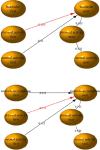Table 4.
Examples of cases with quotes and graphs from the personalized report.
| Case description | Quote | Example network technical report (results only shown when positive estimates (black) or negative estimates (red) > 0.1 and significant) | Example graph personalized report |
|---|---|---|---|
| 1. 16 year old girl with medically unexplained back pain and fatigue. The personalized report shows more fatigue when mental activity is low. During the conversation we discovered that low mental inactivity for her meant also the absence of distraction. She concluded that distraction helps her to take her attention of her symptoms, which may help her. She was referred to a psychologist, with whom she is going to explore how she can use this knowledge to alleviate her symptoms. | “That these things were not only my thoughts, buth there was actually a pattern.” |  |
 |
| 2. 17 year old girl with juvenile idiopathic arthritis. The personalized report shows a contemporaneous association between more fatigue and more mental activity and between more fatigue and more contact with people who bothered her or did not understand her. During our conversation she tells us that she often feels overstimulated in a busy environment by noises, emotions or talk. She concludes that she would be helped if someone could coach her on how to filter and regulate the incoming stimuli, so that they will cost her less energy. | “Yes, now you look at it in another way. You notice for yourself when you’re tired, but you never write it down and now you suddenly see why you’re tired. So then you learn new things, you cannot record everything yourself, so this is nice: to know what makes you tired and what happens if you’re tired. That helped me anyway, this report. I know now precisely how it works.” |  |
 |
| 3. 14 year old girl with Hashimoto thyreoiditis. The personalized report shows that increased mental activity precedes more headache and more restrictions related to her symptoms, while being more physical activity precedes less headache and less restrictions. She tells us that she recognizes herself in this pattern, but she finds it really hard to motivate herself to get more physically active. She finds the possibility of cognitive behavioral therapy with graded exercise an option that may fit her needs. | “It helps, because you know how you feel. If something comes up, it also helps the doctor. The doctor then sees how you’re doing over time and not just at one moment.” |  |
 |
| 4. 18 year old girl with prescleroderma. The personalized report shows that she has more pain in the weekends and when she is physically active. She tells us she intensively exercises in the weekend. She knows she will have more pain then, but accepts it in order to be able to play the hockey games. She does not want to change this. Furthermore, more worrying is followed in time by more fatigue. She tells us that she recognizes that her thinking can be really preoccupied every now and then. She did not make the link to fatigue before, but she is open to consider it as a possible treatment target. | “Most of it I already knew. But you assess everything more thoroughly, so I got a little bit of new insight: that when I worry, it makes me feel more fatigued. That I feel worse after sports I knew, but also the confirmation is nice.” |  |
 |
